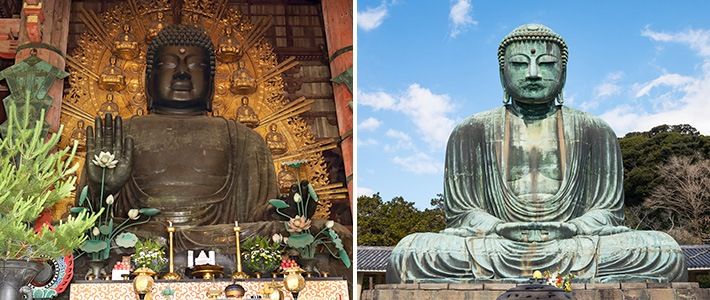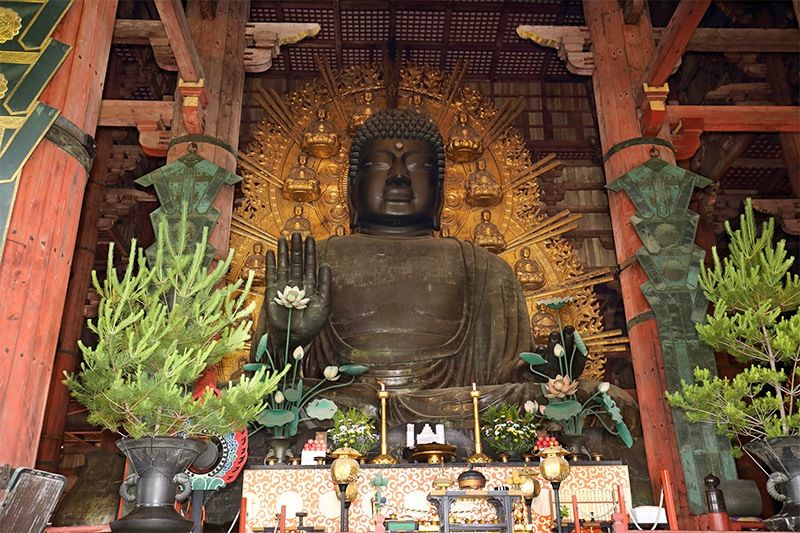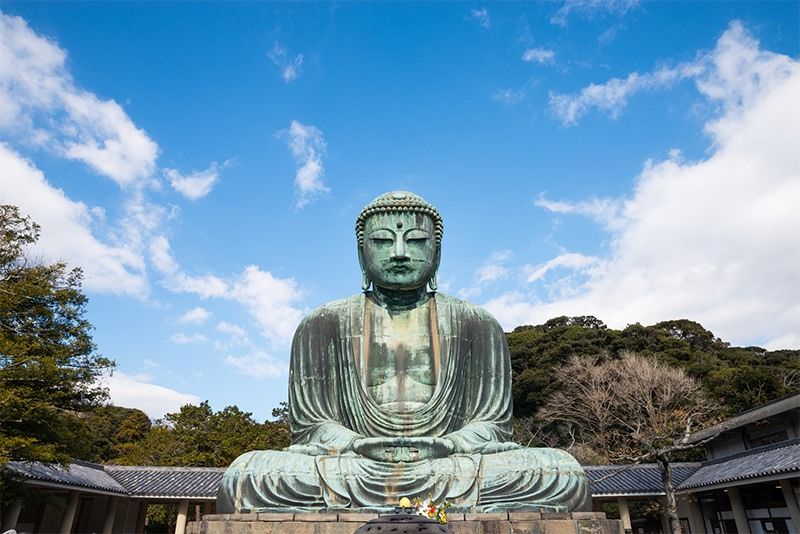
Japan’s Great Buddhas in the East and West
Culture History Guide to Japan- English
- 日本語
- 简体字
- 繁體字
- Français
- Español
- العربية
- Русский
Since Buddhism was first introduced in Japan around the sixth century, a number of Daibutsu, or Great Buddha statues, have been built to pray for national peace and stability—or to hope that everyone from the highest to the lowest can attain a good, rich life. Many Japanese will automatically think of the statues in Nara and Kamakura, which are designated as national treasures. Both are impressive, sitting in their peaceful poses, although the Great Buddha in Nara is greater in size and weighs twice as much.
Comparison of the Sizes of the Great Buddha Statues in East and West Japan
| Nara | Kamakura | |
|---|---|---|
| Total height (including the base) | 18.03 m | 13.35 m |
| Buddha statue height | 14.93 m | 11.31 m |
| Length of face | 5.33 m | 2.35 m |
| Height of hair curls | 0.21 m | 0.18 m |
| Number of hair curls | 492 | 656 |
| Buddha statue weight | 250 tons | 121 tons |
Compiled by Nippon.com based on data from the Kōtoku-in temple in Kamakura and Nara City Tourist Association websites.
Nara Great Buddha (Tōdaiji Buddha/Vairocana Buddha)
Emperor Shōmu requested the construction of this Daibutsu in in the hope of using the power of Buddhism to suppress social unrest due to political change and rebellion, and to protect against epidemics and damage caused by natural disasters. In 752, an eye-opening ceremony was held, ritually imbuing a spirit into the statue. The Daibutsuden Hall, where the Great Buddha is enshrined, was burnt down twice during battles and the statue also suffered damage. The hall was reconstructed during the Edo period (1603–1868) and is the largest wooden structure in the world.
In the northeast part of the hall is a pillar with a hole in it, which is popular with visitors—especially smaller children, who fit through it most easily—because it is said that if you crawl through it, your wish will come true.
- Access: Take the JR Yamatoji Line or Kintetsu Nara Line to Nara Station, then catch the loop line bus to Daibutsuden Kasugataisha-mae and walk five minutes.
- Entrance Fee: ¥600.
Kamakura Great Buddha (Kōtokuin Buddha/Amitabha Buddha)
Construction of this Great Buddha began in 1252 and took approximately 10 years to complete, but the reason why it was built and details such as the date of the eye-opening ceremony are unknown. Many Great Buddha statues are enshrined in halls; however, the one at Kamakura is unusual as it is sits out in the open air. Although there was a Daibutsuden Hall at first, it was destroyed several times by typhoons and earthquakes, so for more than 500 years since 1498, the statue has been open to the elements. While it has sustained damage from being outside, this Great Buddha set against a blue sky possesses a different kind of beauty to that of one under a roof.
As well as viewing the statue from the outside, for a ¥20 entrance fee, visitors can view it on the inside too. It is interesting to see the repair marks that cannot easily be seen from the outside.
- Access: Seven minutes’ walk from Hase Station on the Enoshima Electric Railway. If visitors use the Enoshima Electric Railway bus from JR Kamakura East Exit or the Keikyū bus to Daibutsu-mae bus stop, it is a very short walk.
- Entrance Fee: ¥200 (a separate fee of ¥20 is required to view inside the statue).
Japanese like to group important items in threes, such as the three great types of ramen, the three great waterfalls, and the three great night views. However, there is no fixed group for the three Great Buddhas. Up until World War II, the Hyōgo Great Buddha, built in 1891, completed the trio. However, it was melted down for scrap in 1944. Opinions are now split as to which could be the third Great Buddha: The options include the Hyōgo Great Buddha, rebuilt in 1991, the Takaoka Great Buddha in Toyama Prefecture, and the Gifu Great Buddha in Gifu Prefecture.
By size, the largest such statue in Japan is the Ushiku Great Buddha in Ibaraki Prefecture, which measures 120 meters in height, including the base. It is around three times the height of the Statue of Liberty in New York and is equivalent to a 30-story high-rise building. However, as it was only completed in 1992, it is not considered as the third of the three Great Buddhas.
(Translated from Japanese. Banner photo: The Great Buddha statues in Nara [left] and Kamakura. © Pixta.)

